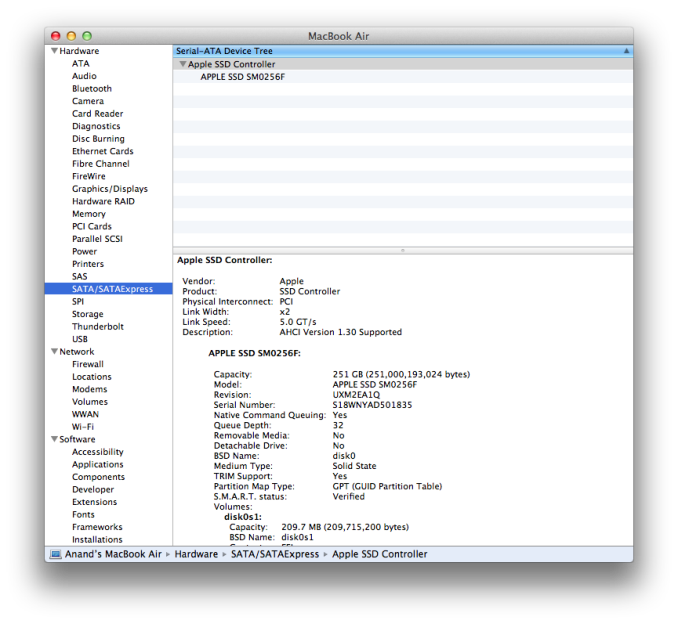The 2013 MacBook Air Review (13-inch)
by Anand Lal Shimpi on June 24, 2013 12:01 AM ESTA Custom Form Factor PCIe SSD
In the old days, increasing maximum bandwidth supported by your PATA/SATA interface was always ceremonial at first. Hard drives were rarely quick enough to need more than they were given to begin with, and only after generations of platter density increases would you see transfer rate barriers broken. Then came SSDs.
Not only do solid state drives offer amazingly low access latency, but you can hit amazingly high bandwidth figures by striping accesses across multiple NAND Flash die. A 256GB SSD can be made up of 32 independent NAND die, clustered into 8 discrete packages. A good controller will be able to have reads/writes in flight to over half of those die in parallel. The result is a setup that can quickly exceed the maximum bandwidth that SATA can offer. Today that number is roughly 500MB/s for 6Gbps SATA, which even value consumer SSDs are able to hit without trying too hard. Rather than wait for another rev of the SATA spec, SSD controller makers started eyeing native PCIe based controllers as an alternative.
You can view a traditional SSD controller as having two sides: one that talks to the array of NAND flash, and one that talks to the host system’s SATA controller. The SATA side has been limiting max sequential transfers for a while now at roughly 550MB/s. The SATA interface will talk to the host’s SATA interface, which inevitably sits on a PCIe bus. You can remove the middle man by sticking a native PCIe controller on the SSD controller. With SATA out of the way, you can now easily scale bandwidth by simply adding PCIe lanes. The first generation of consumer PCIe SSDs will use PCIe 2.0, since that’s what’s abundant/inexpensive and power efficient on modern platforms. Each PCIe lane is good for 500MB/s, bidirectional (1GB/s total). Apple’s implementation uses two PCIe 2.0 lanes, for a total of 1GB/s of bandwidth in each direction (2GB/s aggregate).
The move to a PCIe 2.0 x2 interface completely eliminates the host side bottleneck. As I pointed out in my initial look at the new MacBook Air, my review sample’s 256GB SSD had no problems delivering almost 800MB/s in peak sequential reads/writes. Do keep in mind that you’ll likely see slower results on the 128GB drive.
Users have spotted both Samsung and SanDisk based PCIe SSDs in the 2013 MacBook Airs. Thankfully Apple doesn’t occlude the controller maker too much in its drive names. An SM prefix denotes Samsung:
My review sample featured a Samsung controller. There’s very little I know about the new Samsung controller, other than it is a native PCIe solution that still leverages AHCI (this isn't NVMe). Within days of Apple launching the new MBAs, Samsung announced its first consumer PCIe SSD controller: the XP941. I can only assume the XP941 is at least somewhat related to what’s in the new MBA.
The Samsung controller is paired with a 512MB DDR3 DRAM and 8 Samsung 10nm-class (10nm - 20nm process node) MLC NAND devices.
New PCIe SSD (top) vs. 2012 MBA SATA SSD (bottom) - Courtesy iFixit
Despite moving to PCIe, Apple continues to use its own proprietary form factor and interface for the SSD. This isn’t an M.2 drive. The M.2 spec wasn’t far enough along in time for Apple to use it this generation unfortunately. The overall drive is smaller than the previous design, partially enabled by Samsung’s smaller NAND packages.












233 Comments
View All Comments
darwinosx - Monday, June 24, 2013 - link
They are not biased and you don't understand the meaning of the word.MonkeyPaw - Monday, June 24, 2013 - link
Just a thought, but how about stating your concerns via constructive criticism or in the form of a question. Crying bias while continuing to visit (and therefore, support) any website just doesn't make much sense since you will be dismissed as a troll by the very people you are hoping to influence.CalaverasGrande - Monday, June 24, 2013 - link
Frankly I think users that expect to play heavy 3D games on a MacBook Air with chipset video bought the wrong computer. They should have spent a few hundred more for a 15" MBP with discrete graphics. Or if they really care about games they should hop the fence and go get an Asus or some other Windows gaming notebook.Intel's HD4000 graphics are better than previous Intel video attempts, but still pretty weak compared to other vid chips. It's also using system ram, not dedicated ram.
As stated, this is the mobility platform, not the performance platform.
CalaverasGrande - Monday, June 24, 2013 - link
oops, HD5000.darwinosx - Monday, June 24, 2013 - link
Nobody does. But the HD 5000 is quite capable for some games.hyrule4927 - Monday, June 24, 2013 - link
The lack of thermal data in these Mac reviews is rather frustrating. If this data is included in all other PC reviews in Anandtech, why is it completely ignored when reviewing Apple products? They certainly aren't immune to heat/throttling problems.darwinosx - Monday, June 24, 2013 - link
You didn't read the article you are commenting on.hyrule4927 - Monday, June 24, 2013 - link
If you would like to tell me where specific CPU temperature data is given, be my guest. All I see is an anecdote about fan noise and speculation about throttling in several tests.darwinosx - Monday, June 24, 2013 - link
Prove that Samsung makes a better screen than LG. I bet you can't tell the difference.spronkey - Monday, June 24, 2013 - link
Samsung LCDs might have slightly better early quality control. LG Display have been a bit notorious for early run issues with their panels lately. But I agree - taking these away, LG has more cred as a panel maker than Samsung does.